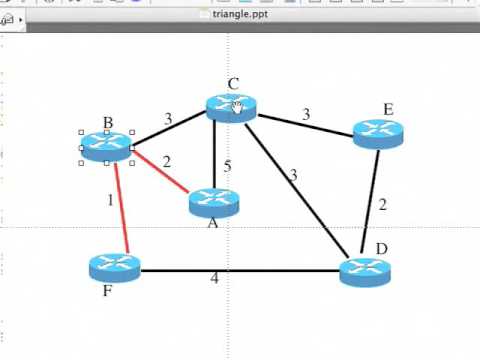In computer networking, efficiency and accuracy in data routing are paramount. The Shortest Path First (SPF) algorithm, also known as the Dijkstra algorithm, stands as a cornerstone for achieving these goals. By meticulously computing the shortest path between every pair of nodes within a network, SPF ensures that data packets are delivered through the most efficient routes possible. This algorithm not only optimizes network performance but also minimizes latency and enhances reliability. While the Open Shortest Path First (OSPF) Protocol employs SPF as its underlying mechanism, understanding SPF in its purest form reveals the fundamental principles of network routing.
This article delves into the intricacies of the SPF algorithm, differentiating it from OSPF, and laying bare its significance in modern networking. Join us as we embark on a journey through the algorithm’s mechanics, applications, and its pivotal role in shaping the landscape of network communication.
Table of Contents:
- What is the Shortest Path First (SPF) Algorithm?
- The Mathematical Genius Behind SPF
- Implementing SPF in Real-World Networks
- SPF Algorithm and Network Optimization
- Difference Between SPF and OSPF
- References

1. What is the Shortest Path First (SPF) Algorithm?
1.1 Definition and Origins
The Shortest Path First (SPF) algorithm, also known as Dijkstra’s algorithm, is a fundamental component in the field of computer networking and graph theory. Conceived by Edsger W. Dijkstra in 1956, it solves the problem of finding the shortest path from a starting node to all other nodes in a weighted graph, where the weights represent the cost, distance, or time to traverse from one node to another. This algorithm’s elegance and efficiency have made it a cornerstone in the design of network routing protocols, notably influencing the development of the Open Shortest Path First (OSPF) Protocol.
1.2 How SPF Works: A Technical Overview
The operation of the SPF algorithm can be distilled into several key steps. Initially, it assigns a tentative distance value to every node: zero for the initial node and infinity for all other nodes. The algorithm then follows a process of discovery and relaxation, where it systematically examines and updates the distances between nodes. At each step, it selects the node with the lowest tentative distance, calculates the distance to its neighbors, and updates their distances if a shorter path is found.

This process repeats until the algorithm has determined the shortest path to all nodes in the network. The use of priority queues in modern implementations optimizes the selection process of the next node to visit, enhancing the algorithm’s efficiency.
1.3 The Role of SPF in Network Routing
In network routing, the SPF algorithm’s ability to swiftly compute optimal paths is invaluable. It underpins the functionality of routing protocols like OSPF, enabling routers to dynamically calculate the most efficient routes for packet delivery across complex, ever-changing network topologies. By ensuring that data packets follow the shortest possible paths, SPF minimizes network latency, reduces congestion, and improves the overall performance and reliability of the network. Its application extends beyond networking to various fields requiring efficient pathfinding solutions, underscoring its versatility and importance.
2. The Mathematical Genius Behind SPF
2.1 Understanding Dijkstra’s Algorithm
Dijkstra’s algorithm exemplifies mathematical elegance in solving the shortest path problem. It is predicated on the principle that any subpath of the shortest path is itself the shortest path between its endpoints. This property, known as the optimality principle, allows the algorithm to progressively build the shortest path tree from the source node, ensuring that once a node’s shortest distance is determined, it is final and optimal.
The genius of Dijkstra’s algorithm lies not only in its simplicity but also in its adaptability to various types of graphs, whether directed or undirected, as long as the edge weights are non-negative.
2.2 SPF Algorithm: Step-by-Step Explanation
- Initialization: Start with a set containing all nodes, assigning a distance of zero to the source node and infinity to all others.
- Selection: Select the unvisited node with the smallest tentative distance. Initially, this is the source node.
- Relaxation: For the selected node, consider all its unvisited neighbors. Calculate their tentative distances through the current node, comparing with the previously recorded distances. Update these distances if lower values are found.
- Finalization: Mark the current node as visited. A visited node will not be checked again; its shortest distance is now set.
- Repetition: Repeat the selection and relaxation steps for the remaining unvisited nodes in the set. The process continues until all nodes have been visited, ensuring the shortest paths from the source to all other nodes in the graph are found.
By applying these steps, the SPF algorithm efficiently computes the shortest paths, embodying a critical tool in network routing and beyond. Its conceptual clarity, coupled with operational efficiency, showcases the mathematical genius behind SPF, making it a fundamental algorithm in computer science and network engineering.
3. Implementing SPF in Real-World Networks
3.1 Practical Applications of SPF
The Shortest Path First (SPF) algorithm is pivotal in various real-world applications beyond its foundational role in network routing protocols like OSPF. Its efficiency in calculating the shortest paths makes it indispensable in traffic navigation systems, where it helps in determining the quickest or least congested routes. In telecommunications, SPF facilitates the optimization of packet routing, ensuring data traverses the most efficient path through the network. Furthermore, it’s employed in logistical and supply chain operations to optimize the routing of deliveries, reducing costs and improving service times. Its versatility extends to social networking platforms as well, where SPF aids in finding the shortest connection paths between users.
3.2 Challenges and Solutions in SPF Implementation
Implementing the SPF algorithm in dynamic, real-world environments presents several challenges. One of the primary issues is the algorithm’s scalability and performance in large, complex networks. As the size of the network increases, so does the computational burden on the algorithm. Solutions include optimizing the data structures used (e.g., priority queues for faster node selection) and employing hierarchical routing to reduce the size of the area that each SPF instance must compute. Another challenge is responding to network changes, such as link failures or additions, which require the algorithm to quickly recalculate paths to maintain optimal routing. Incremental SPF updates, where only the affected parts of the network are recalculated, can address this issue, enhancing the algorithm’s responsiveness and efficiency in dynamic networks.
4. SPF Algorithm and Network Optimization
4.1 How SPF Contributes to Network Efficiency
The SPF algorithm significantly contributes to network efficiency by ensuring data packets take the shortest and most efficient path to their destination. This minimization of path length reduces latency and packet transmission times, leading to faster and more reliable network performance. Additionally, by optimizing the use of network resources, SPF can help balance load across the network, preventing congestion and bottlenecks. This optimization is crucial in maintaining high levels of service quality in various network scenarios, from internet service providers to enterprise networks.
4.2 Case Studies: SPF in Action
One notable case study involves a major internet service provider that implemented SPF to enhance the routing of traffic across its nationwide network. By integrating SPF into its core routing protocols, the provider achieved significant improvements in data transmission efficiency, reducing latency by up to 30% in high-traffic areas. Another example is a global logistics company that utilized SPF to optimize its delivery routes, resulting in a 20% reduction in fuel costs and a notable improvement in delivery times. These cases underscore the tangible benefits of SPF in enhancing operational efficiency and service quality in diverse applications.
5. Difference Between SPF and OSPF
5.1 SPF: The Core of OSPF
The Open Shortest Path First (OSPF) protocol, widely used in IP networks, is built upon the principles of the Shortest Path First (SPF) algorithm. OSPF employs SPF to dynamically calculate the shortest routing paths within a routing domain, adapting to network changes to maintain optimal data flow. The integration of SPF allows OSPF to efficiently manage and distribute routing information, facilitating robust, scalable network operations.
5.2 Key Differences and Similarities
While the SPF algorithm serves as the computational heart of OSPF, significant differences distinguish the two. OSPF is a complex routing protocol that includes mechanisms for routing authentication, area partitioning for scalability, and support for various types of network links. In contrast, SPF is a generic algorithm focused solely on pathfinding. The two share a common goal of efficient path selection, but OSPF extends beyond SPF’s scope with features designed for practical network management and scalability.
6. References
Books and Academic Journals:
- “Algorithms” by Robert Sedgewick and Kevin Wayne, which covers Dijkstra’s algorithm and its applications.
- “Computer Networking: A Top-Down Approach” by James Kurose and Keith Ross, providing insights into the application of SPF in networking.
RFCs and Technical Documents:
- RFC 2328: OSPF Version 2, detailing the OSPF protocol’s specifications and its use of SPF.
- RFC 5340: OSPF for IPv6, discussing the implementation of OSPF, including SPF, in IPv6 networks.
- OSPF-2 Protocol Overview